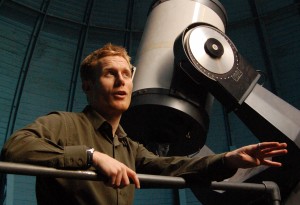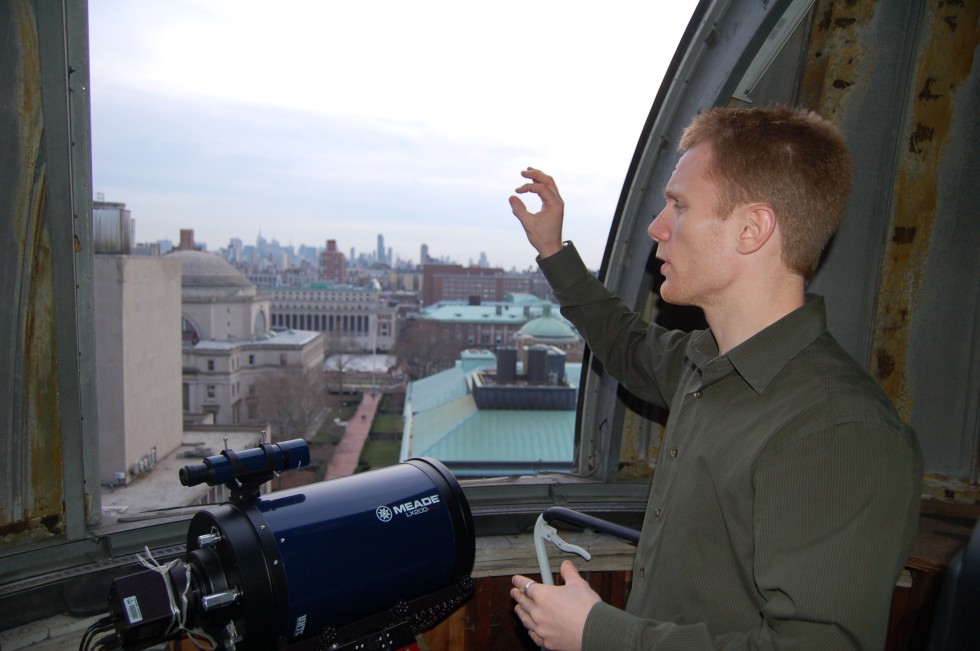
The telescope room atop Pupin Hall at Columbia University offers a stunning view of the night sky and the New York City skyline. Astronomy Ph.D. candidate Cameron Hummels even considered moving his desk and computer up to the rooftop shed before concluding that his computer would not last long without heat or air conditioning. As much as Hummels would like to be near the telescopes all the time, the discoveries he wants to make also require computers, and there’s a lot at stake: “I love the fact that I could potentially make a difference,” he says, “in how we identify the underlying principles of nature.”
Construction at Columbia is beginning to block the telescopes’ view of the western sky, so the university has proposed moving the telescopes to a dormitory roof, which would expose the hidden part of the sky again to researchers. But it might also restrict access for the telescopes’ other function: public outreach nights. Hummels is concerned that it will be difficult to arrange passage through a dormitory for the hundreds of New Yorkers who attend the biweekly events. And Hummels, the telescopes’ de facto caretaker since his arrival at Columbia, takes seriously the outreach role he shares with the telescopes.
It’s in part because of his outreach efforts that Hummels was named a NASA Student Ambassador for the International Year of Astronomy. He has been attracting newcomers to astronomy since he resolved to become a professional astronomer himself. At Wesleyan University in Middletown, Connecticut, where Hummels earned a master’s degree in astronomy, outreach was required. But Hummels’s outreach work at Columbia is voluntary and heartfelt. “I just wish there were more people out there doing science,” he says.
Getting on track
Hummels studied computer science as an undergraduate at Pomona College in Pomona, California. He graduated in 2001, “right at the transition of the [technology] boom from the bubble to the bust,” Hummels says, which made finding a mainstream programming job unappetizing. He had been interested in astronomy as an undergraduate but could not double major, so he decided to use his programming skills to get involved in astronomy research after graduating. He took a job as a research assistant on a massive sky survey in the astronomy department at the University of Virginia in Charlottesville.
His boss, astronomer Steven Majewski, needed help transforming thousands of raw digital telescope images into a form useful for data analysis. It was a good use of his skills at the time, Hummels says, and gave him an inside glimpse of how astronomy research works. When another astronomer offered him a different programming job, though, Hummels turned it down, deciding he was more interested in pursuing his own astronomy research. Majewski suggested he apply to the 2-year astronomy master’s program at Wesleyan. Hummels enrolled in late 2003.
Transitional master’s programs such as Wesleyan’s, and the well-known program at San Francisco State University in California, give students from other backgrounds a chance to master the fundamental math, physics, and computer skills that astronomy or physics majors obtain in a research-intensive undergraduate program.
“It’s been a little bit slower than it would have been if I’d had my mind made up when I finished” college, Hummels says, but he’s pleased with his path–especially because Wesleyan provided him with his first taste of public outreach. Wesleyan required Hummels to spend a few hours hosting public observing sessions each month, during which he was responsible for sharing science with the public. He relished the experience.
Jacqueline van Gorkom, a Columbia astronomy professor who was on the graduate admissions committee when Hummels applied from Wesleyan, says it was clear that Hummels was “very motivated, very serious” during his transitional studies. The Columbia astronomy department, she says, often accepts students who, like Hummels, did other things before settling on a Ph.D. in astronomy. Plenty of good students “don’t know what to do in college,” then figure it out later, she adds.
Track record
Today, Hummels’s main research area is galaxy formation. He uses computer models to recreate the structures and dynamics astronomers observe through their telescopes. He is also involved in a project using one of the telescopes on the roof to look for gas escaping from the moon’s surface.
When Hummels arrived at Columbia in 2005, only a dozen or so amateur astronomers attended the biweekly open telescope nights hosted by the astronomy department, says David Helfand, the department chair. Hummels and fellow graduate student Neil Zimmerman began recruiting members of the department to give lectures before the telescope viewing, figuring that if the weather didn’t cooperate, people would still have a reason to take the elevator up to the physics building’s roof. “The lectures are now the draw,” Helfand says. Sometimes they attract more than 100 people.
Hummels provides logistical support, scheduling speakers and volunteers, maintaining equipment, and promoting the events via a Web site, mailing lists, and posters. “Everybody from literally undergraduate majors to me has done one of the lectures in the series over the last year,” Helfand says.
Faculty members say that enthusiasm for outreach waxes and wanes in the department and usually is driven by especially motivated graduate students. One reason is that outreach takes time away from research and publishing. But some members of the department, notably Helfand and Van Gorkom, are supportive of activities outside of classwork and research. The traditional faculty career track isn’t the only goal for all astronomy Ph.D. students, Helfand says, and it’s unhealthy to treat “everything else [as] a second-class, less important activity.” Helfand says he and Van Gorkom take into account students’ outreach efforts when they write evaluations each semester.

On the horizon
This year, Hummels will serve as one of 46 NASA Student Ambassadors, selected for their outreach efforts and for their ability to generate public attention for NASA’s space discoveries during the International Year of Astronomy. Hummels wants to use the $2700 in grant money NASA provided to support his ambassadorship “to court the public.” He plans to organize telescope viewings on the streets of New York City, where he hopes to find “people who don’t encounter astronomy in their everyday lives.”
Another part of his proposal is to build a scale model of the solar system within Manhattan, with a model of the sun in Battery Park, inner planets throughout downtown and midtown, and outer planets in the Bronx. “I still need to reach the city hall folks,” Hummels says, but he appears unfazed by potential bureaucratic roadblocks.
Hummels also plans to expand the lecture series to include the history of astronomy and the science of volcanoes and weather on other planets. “Few of us actually do planetary science,” Hummels says of his departmental colleagues, but NASA encourages its ambassadors to tackle subjects that are grounded in things the public can easily visualize.
Hummels thinks a traditional astronomy research career is the career path he is most likely to choose, be it at a university, an observatory, or a NASA center. He is confident that his outreach efforts will be of value in his astronomy career, especially when he applies for the ultimate NASA ambassador role: that of a scientist-astronaut. He plans to apply once he completes his Ph.D., possibly as soon as 2010. “The time that you’re not training or up there [in space], you’re an advocate for NASA. You are an outreach person for NASA, so they want people who have that kind of background,” Hummels says. Hummels certainly has it.
First published by Science Careers: [html] [pdf]
NB: While Cameron was showing me around on the roof of the building, he found a $20 bill wedged in a hard-to-reach nook between a telescope dome and a brick wall. The incident didn’t make it directly into the story…but may have inspired the title.